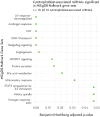Profiling the cell-specific small non-coding RNA transcriptome of the human placenta
- PMID: 40287577
- PMCID: PMC12033255
- DOI: 10.1038/s41598-025-98939-4
Profiling the cell-specific small non-coding RNA transcriptome of the human placenta
Abstract
The human placenta is the composite of multiple cell types, each which contributes uniquely to placental function. Small non-coding RNAs (sncRNAs) are regulators of gene expression and can be cell-specific. The sncRNA transcriptome of individual placental cell types has not yet been investigated due to difficulties in their procurement and isolation. Using a custom sequencing method, we explored the expression of seven sncRNA species (miRNA, piRNA, rRNA, scaRNA, snRNA, snoRNA, tRNA) from whole chorionic villi and four major sample-matched FACS-sorted cell type (cytotrophoblast, stromal, endothelial, Hofbauer) samples from 9 first trimester and 17 term placentas. After normalization for technical variables, samples clustered primarily by cell type lineage. No sncRNAs were uniquely expressed by cell type, however, mean expression differed by cell type for 115 sncRNAs. Known placentally-expressed sncRNAs showed differing expression by cell type and trimester. Expression of few sncRNAs varied by sex. Lastly, sample-matched sncRNA expression and DNA methylation correlation was not significant, although high correlation (> R2 ± 0.6) was observed for some sncRNA-CpG pairs. This study represents the first exploration of the sncRNA transcriptome of bulk placental villi and placental cell types, informing about the expression and regulatory patterns underlying human placental development.
Keywords: Chorionic villi; MiRNA; Placenta; Small non-coding RNA; Trophoblast.
© 2025. The Author(s).
Conflict of interest statement
Declarations. Competing interests: The authors declare no competing interests. Ethics approval and consent to participate: Written informed consent was obtained from all participants including a tissue banking consent. This study was approved by The University of British Columbia and BC Women’s and Children’s Hospital research ethics board in Vancouver, BC, Canada (certificate number: H16-02280).
Figures




Update of
-
Profiling the cell-specific small non-coding RNA transcriptome of the human placenta.Res Sq [Preprint]. 2025 Feb 12:rs.3.rs-5953518. doi: 10.21203/rs.3.rs-5953518/v1. Res Sq. 2025. Update in: Sci Rep. 2025 Apr 26;15(1):14666. doi: 10.1038/s41598-025-98939-4. PMID: 39989957 Free PMC article. Updated. Preprint.
Similar articles
-
Profiling the cell-specific small non-coding RNA transcriptome of the human placenta.Res Sq [Preprint]. 2025 Feb 12:rs.3.rs-5953518. doi: 10.21203/rs.3.rs-5953518/v1. Res Sq. 2025. Update in: Sci Rep. 2025 Apr 26;15(1):14666. doi: 10.1038/s41598-025-98939-4. PMID: 39989957 Free PMC article. Updated. Preprint.
-
Profiling the small non-coding RNA transcriptome of the human placenta.Sci Data. 2021 Jul 2;8(1):166. doi: 10.1038/s41597-021-00948-1. Sci Data. 2021. PMID: 34215751 Free PMC article.
-
Sex differences in the late first trimester human placenta transcriptome.Biol Sex Differ. 2018 Jan 15;9(1):4. doi: 10.1186/s13293-018-0165-y. Biol Sex Differ. 2018. PMID: 29335024 Free PMC article.
-
Revealing the molecular landscape of human placenta: a systematic review and meta-analysis of single-cell RNA sequencing studies.Hum Reprod Update. 2024 Jul 1;30(4):410-441. doi: 10.1093/humupd/dmae006. Hum Reprod Update. 2024. PMID: 38478759 Free PMC article.
-
Current approaches and developments in transcript profiling of the human placenta.Hum Reprod Update. 2020 Nov 1;26(6):799-840. doi: 10.1093/humupd/dmaa028. Hum Reprod Update. 2020. PMID: 33043357 Free PMC article. Review.
References
MeSH terms
Substances
Grants and funding
LinkOut - more resources
Full Text Sources

